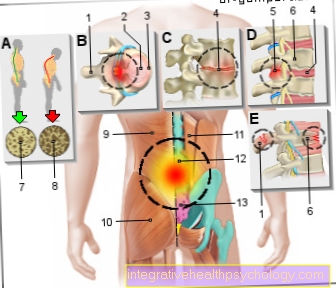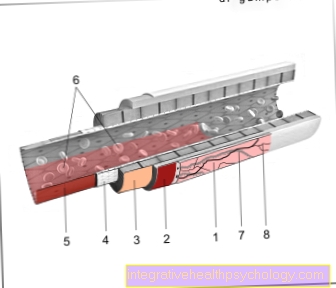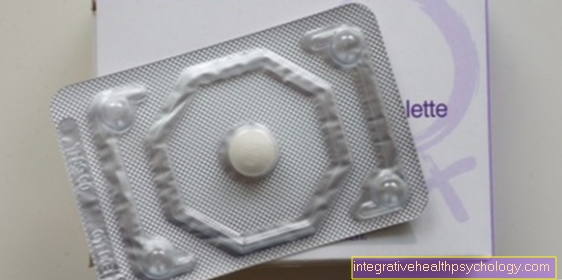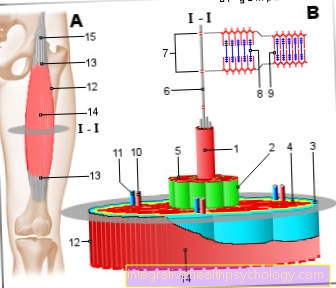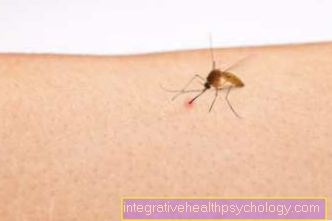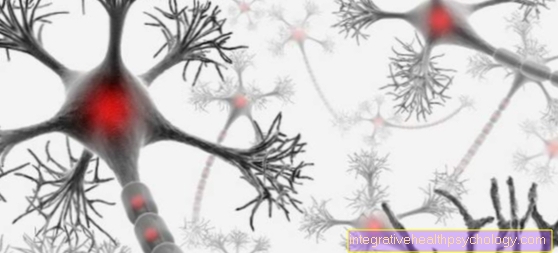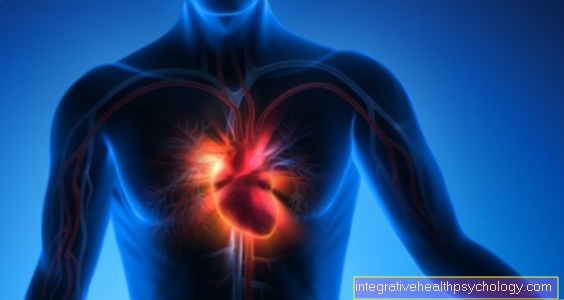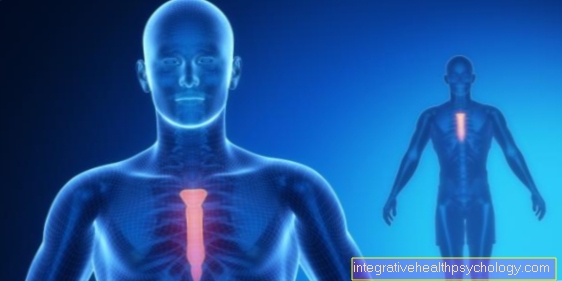histamine
definition
Histamine is one of the so-called biogenic amines and fulfills a number of different tasks in the human body. Histamine is contained in food in more or less high concentrations and can thus be absorbed by the body through food. If the breakdown of histamine is impaired, a so-called histamine intolerance can occur. There are four known different receptors in the body to which histamine can bind and fulfill various functions.

Function and effects of histamine in the body
Histamine does one Variety of essential tasks in the body. It is assumed that not all of the functions of histamine have been explored and that studies over the next few years will reveal a number of other functions of the messenger substance.
Histamine for inflammation
Most of all, histamine serves as a Messenger substance in inflammatory and allergic processes. In the case of inflammation, the release of histamine ensures that Blood vessels wide as well as that Tissue swells. The release of other substances that are required in the event of inflammation is also caused by histamine. It thus supports the body in Control of invading pathogens. Blood vessels are widened to allow more blood to reach the inflamed area and allow the body's immune cells to fight the invader. This can be recognized externally by reddening of the skin or mucous membrane.
Histamine is also for the Itching and runny or blocked nose if you have an allergy responsible. The swelling of the mucous membranes and thus congestion of the nose should lead to the entry port being closed. The person concerned notices this from poor breathing. If there is a strong allergic reaction, there is also a General condition deterioration, Tiredness, exhaustion, headache and malaise. Sometimes also can fever associated with these allergic symptoms. Since the histamine effect occurs very quickly in an allergic reaction, one also speaks of the so-called Immediate response.
Histamine in the central nervous system
Histamine also plays an important role in the central nervous system. This is how it serves as a neurotransmitter transmitting important information. Especially the one Nausea and the sleep rhythm are significantly influenced by histamine. By blocking certain receptors, histamine can also influence the release of other messenger substances in the brain. Current studies are investigating other possible tasks that histamine may have in the brain.
Digestion and cardiovascular system
The presence of histamine is also an important factor in digestion. So histamine is essential for that Gastric acid production responsible and stimulates digestion through a increased bowel movement on.
In the cardiovascular system, histamine causes the small vessels to widen, while large vessels become narrow due to the influence of histamine, which causes the Affects blood pressure. The beating power of the heart and the frequency of the heartbeat are increased by histamine.
The breakdown of histamine
The breakdown of histamine takes place via a number of different enzymes and intermediate substances in the body. After the histamine passes through the stomach, most of it becomes absorbed in the intestine. In the body, it becomes above all from the so-called Diamine oxidase reduced. The end product is created through various intermediate products Imidazolylacetic acid. This is usually excreted with the urine via the kidneys.
The breakdown of the histamine occurring in the brain, which fulfills its function there as a neurotransmitter and messenger substance, takes place via other enzymes compared to the rest of the histamine.
Histamine allergy / histamine intolerance
An allergy to histamine per se is not yet known, mostly one means that Histamine intolerance. An allergy to histamine would lead to significant allergic reactions in the event of mere skin contact or the consumption of only small amounts of histamine. Since histamine is required for a number of important functions in the human body, a classic allergy to histamine is also unlikely.
Eating foods containing histamine can lead to so-called pseudo-allergic reactions, whereby a histamine intolerance is the cause of the problem. In this clinical picture, the activity of the enzyme that breaks down histamine, the diamine oxidase, is reduced. This leads to a build-up of histamine in the body.
However, histamine plays an important role in allergic reactions to other substances, which is why it is In the case of histamine intolerance, the accumulation of histamine in the body often leads to symptoms that typically occur in classic allergies. The main symptoms of an allergic reaction are such as Skin rash caused by allergies, eczema, redness, difficult breathing, a "runny" nose, increased heart rate, fatigue and tiredness as well as sleep disorders. Also the appearance of a headache or one migraine can be typical of the effects of histamine in the body. All of these symptoms reflect the effects of histamine in the body.
To diagnose histamine intolerance, one should first Symptom diary are made, in which it is written down which symptoms occur when and which foods and, above all, when were consumed. The doctor (in this case a gastroenterologist) also measures the histamine level in the blood and sees whether it is permanently elevated. There is also the possibility of so-called Provocation tests perform. These tests are offered in specialist clinics. In this test procedure, the patient is given certain substances containing histamine and the reactions are then observed. Appropriate emergency equipment is essential in this process.
The Avoid foods that contain particularly histamine can lead to a complete freedom from symptoms in people who are affected by histamine intolerance. The symptoms caused by histamine in an allergic reaction to other substances can be reduced by taking certain medications. So-called Antihistamines can alleviate the symptoms of allergic reactions by inhibiting the effect of histamine on their receptors
Histamine in foods
Histamine is found in a variety of different foods and can be absorbed by the body through the intestines. The concentration of histamine varies depending on the food. There are some foods that typically have a very high histamine content, while other foods contain little or no histamine. Since the body only needs very little histamine and can produce it itself from other substances, the intake of histamine through food is not absolutely necessary.
Histamine intake through food becomes problematic if there is a so-called histamine intolerance. In this case, the breakdown of histamine is disturbed. Due to the reduced breakdown of histamine, so-called pseudo-allergic reactions can occur in those affected when histamine contained in food is ingested.
Histamine in alcohol
Alcohol is the most common reason for complaints in the case of histamine intolerance. Almost all alcoholic beverages have a more or less high histamine content. The values fluctuate strongly and depend not only on the brand but also on the vintage. In the production of alcohol, the histamine content increases with increasing preservation through added substances, as well as increasing ripeness. So old and ripe wines have a significantly higher histamine content than young wines. With beers, the fermentation stage is important. This is how top-fermented and bottom-fermented stages are distinguished. Top-fermented beers have a significantly higher histamine content than bottom-fermented beers.
Patients with severe histamine intolerance should completely refrain from consuming alcoholic beverages. Just drinking a beer can trigger corresponding complaints. In addition to its own histamine content, alcohol also has an effect in addition, an increased release of the body's own histamine. So after consuming alcohol, the body becomes flooded with a large amount of histamine. By a additional widening of the blood vessels alcohol causes an aggravation of the symptoms of histamine intolerance.
Histamine in coffee
Coffee is a drink that many people like to drink and can lead to symptoms if they have a known histamine intolerance. The decisive factor here is not the histamine content in the coffee but the contained caffeine, which reduces the activity of the enzyme diamine oxidase and thus makes the breakdown of histamine more difficult. Especially when consuming caffeinated coffee in combination with eating foods containing histamine, symptoms can arise. Coffee that does not contain caffeine is therefore unreservedly recommended even if you have a histamine intolerance, while drinks containing caffeine such as Classically brewed coffee or cola tend to be avoided. As a rule, depending on the severity of the individual histamine intolerance, the consumption of small amounts of coffee or other caffeinated drinks is not a problem. However, when drinking large amounts of coffee, typical symptoms of histamine intolerance can occur.
The histamine table
The histamine table is an instrument developed by nutritionists to reduce the daily histamine intake through food in the case of histamine intolerance. The histamine table includes the common foods that are consumed during the day and provides them with symbols that inform the user whether the product contains histamine and whether it is safe to consume. The table also distinguishes between parental leave and long-term consumption. For example, some products should not be eaten regularly due to increased histamine levels, but others can be consumed without hesitation after a subsequent break. The histamine table is constantly being expanded. It can be found online on the Internet or from nutritionists, sometimes even from pharmacies.
Histamine diet for histamine intolerance
Since foods have different levels of histamine concentrations, the individual diet plays a decisive role in the amount of histamine that is absorbed by the body through food.
Normally you don't have to worry about how much histamine is ingested through food. The body can absorb this with the help of various enzymes and break it down into other substances. Worries that the individual diet is not supplying enough histamine are also unfounded. The amounts of histamine the body needs are very small. The body is also able to produce the histamine it needs from other substances, which is why a small amount of the messenger substance through food is not important.
The situation is different for people who suffer from so-called histamine intolerance. Affected people are unable to break down the histamine they have absorbed because of an enzyme defect. The resulting larger amount of histamine can lead to discomfort. A special diet in which certain foods are selected to ensure that as little or no histamine as possible is absorbed through the diet can help in these cases to be free of symptoms. For example, if you have a histamine intolerance smoked fish and meat as well as certain vegetables, fruits and alcohol Be avoided. Eating other foods that have only a low direct histamine concentration, but also inhibit the impaired enzyme (caffeine), should also be avoided on a low-histamine diet.



